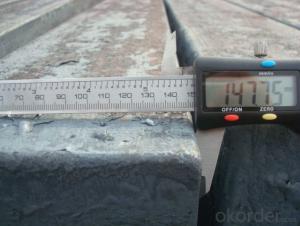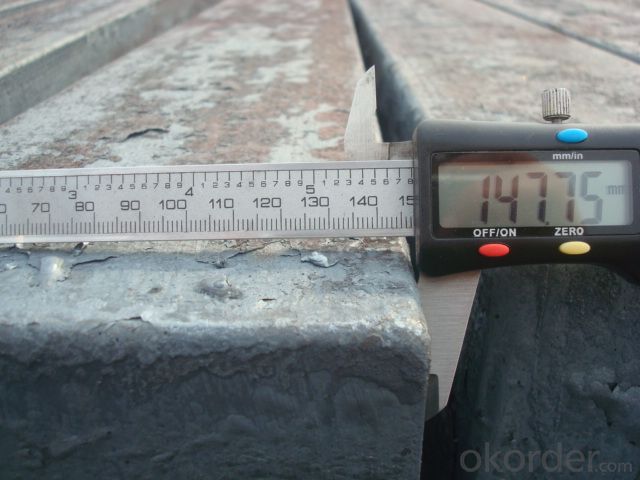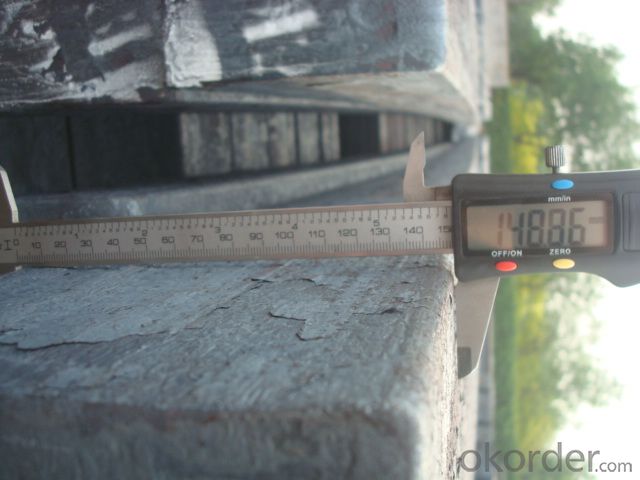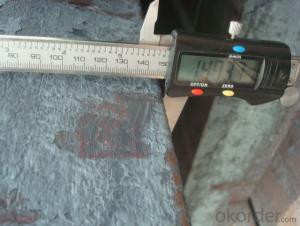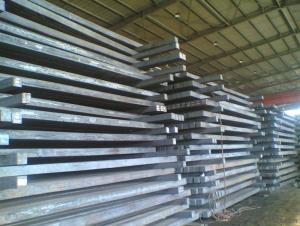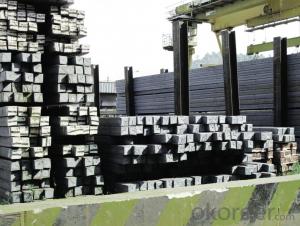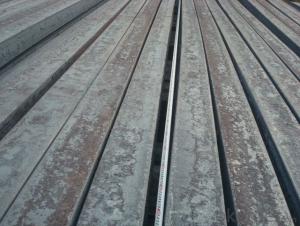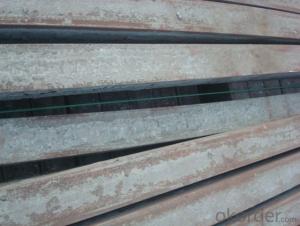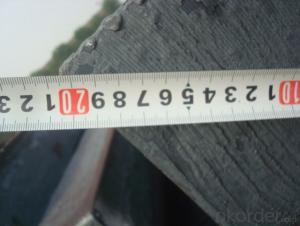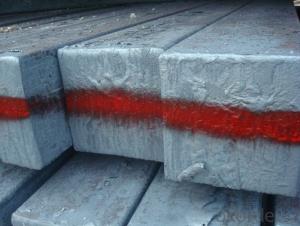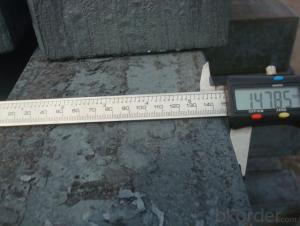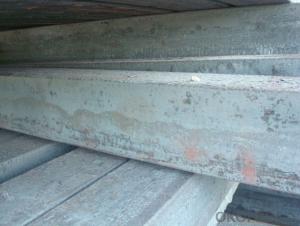Alloyed Steel Billets or Blooms Manufactured by Continue Casting Furnace
- Loading Port:
- Tianjin
- Payment Terms:
- TT OR LC
- Min Order Qty:
- 1000 m.t.
- Supply Capability:
- 10000 m.t./month
OKorder Service Pledge
OKorder Financial Service
You Might Also Like
Alloyed Steel Billets or Blooms Manufactured by Continue Casting Furnace
1.Structure of Alloyed Steel Billets or Blooms Manufactured by Continue Casting Furnace
Steel Billets Manufactured by Continue Casting is the raw material of all kinds of steel mill. Billet section of square, round, flat, rectangular and abnormity, etc Several, mainly related to shape of rolled products. Simple rolled section steel, choose cross section of square billet or rectangular billet. rolling The sector products such as flat steel, Angle steel, select the rectangular billet or slab. Had better profiled billet when production beams, channels, and in rolling process Lines and improve the yield. The raw material of round billet is the production of seamless tube.
2.Main Features of Alloyed Steel Billets or Blooms Manufactured by Continue Casting Furnace.
Steel Billets Manufactured by Continue Casting section size should meet the requirements of rolling deformation and finished product quality, but also roll strength and biting condition of restrictions. General steel Billet section height H. And the roll diameter D The ratio of the ( namely H/D) Should be less than or equal to zero 0.5 . Length of steel billet by finishing temperature, Rolling time and the length of the product Or times ruler. When heated too long accident prone to bump the furnace wall of steel, too short, furnace bottom utilization rate is not high, influence the heating furnace production. For the production Choose a variety of steel and steel billet, should consider the affinities of billet, as far as possible in order to improve the productivity of the roughing mill, simplify the stock management of workshop.
There are three shapes of the steel billets: square billet, slab, rectangular billet The Chinese billet, rectangular billet is mainly suitable for rolling hot rolled strip, building reinforced bar, Ordinary wire, high speed wire rod and various small profile. Of the slab are mainly used for rolling plate and hot coil sheet.
3. Alloyed Steel Billets or Blooms Manufactured by Continue Casting Furnace Images
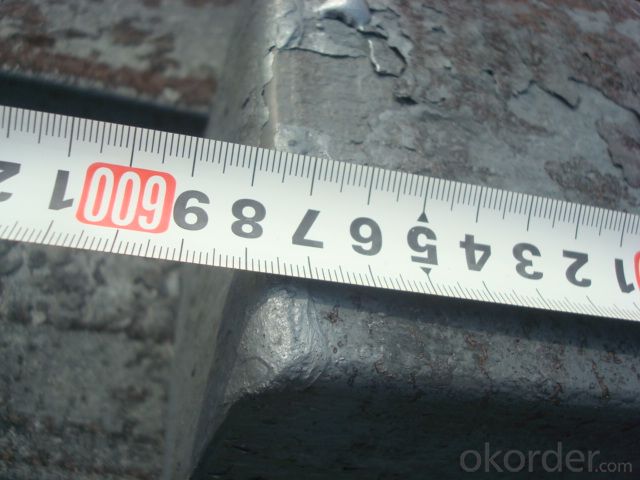
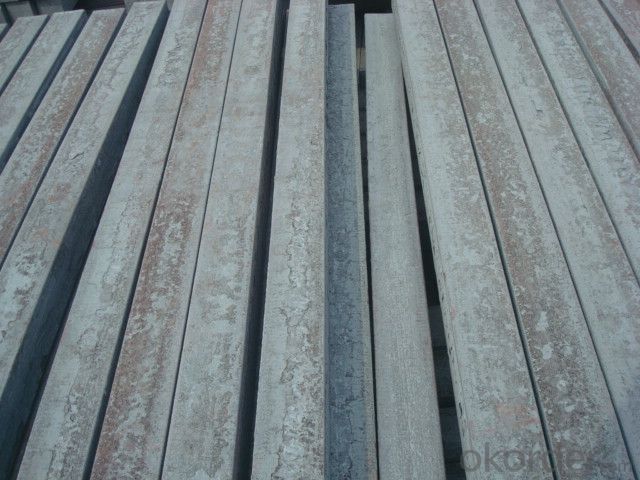
4. Alloyed Steel Billets or Blooms Manufactured by Continue Casting Furnace Specification
Steel Billets Manufactured by Continue Casting rolled steel, after processing can be used for mechanical parts, forging parts, processing all kinds of steel, steel Q345B channel steel, wire rod is the role of the billet. Steel billet is used in the production of semi-finished products, generally cannot be used directly for the society. Steel billets and steel are strictly divided into standard, cannot decide to whether the business enterprise of the final product, and according to unified standards to perform the whole society. Typically, billet and the steel is relatively easy to distinguish, but for some steel billet, and have the same specification and same steel purposes (such as rolling tube billet), whether can be used for other industries, whether through steel processing process, whether through a finished product rolling mill processing to distinguish
Material standard The editor Range of thickness: 150-240 - mm + / - 5 mm width range: 880-1530 - mm + / - 20 mm Length: 3700-10000 - mm + / - 500 - mm Cross-sectional size: 64 * 64; 82 * 82; 98 * 98; 124 * 124; 120 * 150; 152 * 164; 152 * 170 mm Length: 9000 mm Section of tolerance: billet: 1.0 + / - 2.0-1.0 + / - 1.0 mm slab: width: + / - 2.0 mm thickness: + / - 3.0 mm The length tolerance: + / - 200 mm Section diagonal tolerance: 3.5-8.0 MM Billet section size protrusions requirements: < 1242 mm, do not allow; > = 1242 mm, < = 2 mm 1242 mm, < = 3 mm Beheading (shear) extension deformation: < 1242 mm billet: no control; The slab: < = 15 mm Surface tilt: no more than billet section 0.1 Bending: every 1 m length is not more than 10 mm The distortion: length < = 5 m, < = 11. ; The length of the < = 7.5 M, < = 5. Material % 3 sp/PS chemical composition: C Mn Si S P
5.FAQ of Alloyed Steel Billets or Blooms Manufactured by Continue Casting Furnace
We have organized several common questions for our clients,may help you sincerely:
①How about your company?
A world class manufacturer & supplier of castings forging in carbon steel and alloy steel,is one of the large-scale professional investment casting production bases in China,consisting of both casting foundry forging and machining factory. Annually more than 8000 tons Precision casting and forging parts are exported to markets in Europe,America and Japan. OEM casting and forging service available according to customer’s requirements.
②The causes of surface transverse crack and prevent method have?
Transverse cracks in the slab vibration mark the surface of the inner arc wave trough, is usually not hidden, crack depth can be up to 7 mm, width is 0.2 mm.Cracks in the existing body of the mesh area.The cause of general is disorder caused by the continuous casting process control.Such as: vibration mark too deep, Al, N content in steel, prompting particle (A1N) in the grain boundary precipitates, induced transverse crack;Billet straightening within the range of brittleness temperature 700 ~ 900 ℃;Secondary cooling is too strong, and so on. Continuous casting process and some measures to prevent the transverse crack in general are: mold using high frequency small amplitude;With smooth and weak cooling, secondary cooling and make the slab surface temperature greater than 900 ℃;Mould liquid level is stable, and USES the good lubrication performance, low viscosity of protecting slag. In general, M - EMS has little effect on the transverse crack, but the end of the electromagnetic stirring (F - EMS) can make the slab surface temperature picks up, can make the transverse crack caused by vibration mark (small) in the next row, especially the air cooling zone, not force and continue to expand, especially for casting machine technology of straightening temperature may be lower than 900 ℃, more degradation effect
③What is the advantage of the continue Casting steel billet comparing to the die casting steel billet?And how is the process?
Compared with die casting, continuous casting has the advantages of: 1. To simplify the Steel billet The production process 2. Improve the metal yield 3. Improve the quality of the billet 4. Reduces the steel worker's labor intensity 5. Save energy and reduce consumption
Steel billet is produced by the method of through three processes: It is through the steelmaking system of continuous casting equipment, directly by the molten steel pouring into billet; The second is the steelmaking system in the production of steel ingot casting billet through system of steel rolling rolling equipment or processing of steel semi-finished products; Three is the steelmaking system production of steel ingot by forging the semi-finished product processing equipment.
- Q: How is the quality of steel billets ensured during production?
- To ensure the quality of steel billets, various measures are implemented during the production process. Here are several key factors that contribute to this: 1. Raw materials selection: High-quality raw materials like iron ore, coal, and scrap metal are carefully chosen for the production of steel billets. These materials undergo rigorous testing to ensure they meet the necessary specifications and standards. 2. Melting and refining: The raw materials are melted and refined to produce the steel billets. This stage utilizes advanced technologies and equipment to control temperature and chemical composition, ensuring consistency and uniformity in the final product. 3. Continuous casting: The molten steel is poured into a continuous casting machine, where it solidifies into billet form. This process allows for precise control over cooling, resulting in billets with uniform dimensions and internal structure. 4. In-line inspection: Modern production facilities incorporate in-line inspection systems that continuously monitor and analyze the quality of the steel billets. Techniques like laser measurement, ultrasonic testing, and magnetic particle inspection are used to detect defects or abnormalities. 5. Heat treatment: Steel billets may undergo heat treatment processes like annealing or quenching to enhance their mechanical properties and eliminate residual stresses. These treatments are carefully controlled to achieve desired results and improve overall quality. 6. Testing and quality control: Comprehensive testing is conducted on the steel billets to ensure they meet required standards. Mechanical and chemical tests, such as tensile strength, hardness, and chemical composition analysis, are performed. Non-destructive testing methods like ultrasonic testing and X-ray inspection are used to detect internal defects or flaws. 7. Traceability and documentation: Detailed documentation is maintained throughout the production process to track each batch of steel billets. This includes information on the raw materials used and final testing results, ensuring traceability and providing a record for quality control purposes. By implementing these measures and following strict quality control procedures, steel manufacturers can ensure that the produced steel billets meet required standards and are suitable for further processing and use in various industries.
- Q: What are the common applications of steel billets?
- Steel billets are semi-finished products that are used in various industrial applications. Some of the common applications of steel billets are: 1. Construction: Steel billets are widely used in the construction industry for structural purposes. They are used to manufacture beams, columns, and other load-bearing components in buildings, bridges, and other structures. The high strength and durability of steel billets make them ideal for withstanding heavy loads and providing structural integrity. 2. Automotive Industry: Steel billets are extensively used in the automotive industry for manufacturing various components such as crankshafts, camshafts, connecting rods, and gears. The excellent mechanical properties of steel billets ensure the reliability and performance of these critical automotive parts. 3. Machinery and Equipment Manufacturing: Steel billets are used in the production of machinery and equipment. They are utilized for manufacturing parts like gears, shafts, valves, and hydraulic cylinders. The versatility of steel billets allows for the customization of these components to meet specific operational requirements. 4. Electrical Industry: Steel billets find applications in the electrical industry for the production of electrical transformers and electric motor cores. The high magnetic permeability and electrical conductivity of steel make it an ideal material for these applications. 5. Pipe Manufacturing: Steel billets are commonly used in the manufacturing of pipes and tubes. They are processed through various techniques such as hot rolling, cold rolling, and extrusion to produce seamless or welded pipes. The strength and corrosion resistance of steel billets make them suitable for transporting fluids and gases in industries like oil and gas, water supply, and construction. 6. Shipbuilding: Steel billets are crucial in shipbuilding due to their strength, durability, and resistance to corrosion. They are used to manufacture various ship components such as hulls, frames, and bulkheads. The ability of steel billets to withstand harsh marine environments makes them an ideal choice for constructing ships and offshore structures. Overall, steel billets are versatile materials that find applications in a wide range of industries, thanks to their excellent mechanical properties, durability, and ability to be customized to meet specific requirements.
- Q: How are steel billets transported and stored?
- In order to guarantee the quality and safety of steel billets, a careful and systematic approach is typically employed in their transportation and storage. In terms of transportation, trucks and railcars are commonly utilized for moving steel billets. Trucks are frequently used for short distances within a steel mill or between different facilities, while railcars are preferred for longer distances, including intercity or even international transport. To load the steel billets onto trucks or railcars, cranes or forklifts are utilized. It is of utmost importance to properly secure the billets to prevent any movement or damage during transit. Straps, chains, or other securing methods are employed to maintain the billets in position and ensure their stability. Once the steel billets arrive at their destination, similar lifting equipment is used to unload them. It is crucial to handle the billets with caution during the unloading process to prevent any scratches or dents that could compromise their structural integrity. In terms of storage, designated areas known as billet yards or billet storage facilities are typically used for housing steel billets. These areas are specifically designed to accommodate the size and weight of the billets and provide easy access for loading and unloading operations. Steel billets are often stored in stacks or piles, with each billet being carefully positioned to maintain stability and prevent any potential accidents. The billets may be organized based on various criteria, such as size, grade, or production date, in order to facilitate their retrieval when necessary. To protect the billets from environmental factors such as humidity or corrosion, they are often coated with protective coatings or stored in enclosed areas with controlled climate conditions. Additionally, regular inspections and maintenance are conducted to ensure the quality and integrity of the stored billets. In conclusion, proper procedures for transportation and storage are crucial for safeguarding steel billets and preserving their quality until they are ready for further processing or use in various industries.
- Q: What are the safety precautions in handling steel billets?
- Handling steel billets requires adherence to specific safety precautions to prevent accidents and injuries. Some of the key safety precautions include: 1. Personal Protective Equipment (PPE): Always wear appropriate PPE, such as safety glasses, gloves, steel-toed boots, and protective clothing, to protect against potential hazards like sharp edges, falling objects, and flying debris. 2. Lifting Techniques: Use proper lifting techniques, such as bending the knees and lifting with the legs, to avoid strains or injuries to the back. If the billets are too heavy to lift manually, use mechanical lifting equipment like cranes or forklifts. 3. Secure Storage: Ensure that steel billets are stored in a secure and stable manner to prevent them from toppling or rolling, which can cause injuries or damage to equipment and infrastructure. Utilize appropriate storage racks, bins, or pallets to keep the billets organized and secure. 4. Handling Tools: Use suitable tools like lifting hooks, clamps, or tongs to handle steel billets safely. Avoid using your hands or body to move or reposition the billets, as this can lead to pinching, crushing, or cutting injuries. 5. Clear and Well-Defined Work Area: Maintain a clear and well-defined work area around the steel billets to prevent tripping hazards. Remove any obstructions or debris that could cause slips, trips, or falls. 6. Communication and Training: Ensure that all personnel involved in handling steel billets are adequately trained in safe handling procedures and are aware of potential hazards. Establish clear communication channels to coordinate movements and actions, especially when using machinery or working in teams. 7. Inspection and Maintenance: Regularly inspect the condition of the steel billets, lifting equipment, and storage racks to identify any potential safety issues. Promptly address any defects, damages, or wear and tear to prevent accidents. 8. Emergency Procedures: Establish emergency procedures and ensure that all personnel are aware of them. This includes procedures for handling accidents, injuries, spills, or other emergencies that may occur during the handling of steel billets. By following these safety precautions, the risk of accidents and injuries can be minimized, creating a safer working environment for all individuals involved in handling steel billets.
- Q: How do steel billets contribute to the telecommunications industry?
- Steel billets are used in the telecommunications industry to manufacture various infrastructure components such as towers, poles, and cables. These components provide the necessary support and stability for the installation of telecommunication equipment, ensuring reliable and efficient communication networks. Steel billets contribute to the industry by providing the raw material needed for the production of these essential infrastructure components.
- Q: How do steel billets contribute to the overall sustainability of a structure?
- Steel billets play a crucial role in enhancing the overall sustainability of a structure in several ways. Firstly, steel is a highly durable material that has a long lifespan, meaning structures built with steel billets will have a longer service life and require fewer replacements or repairs. This reduces the consumption of resources and materials needed for construction, thereby minimizing waste and conserving energy. Additionally, steel is 100% recyclable, which means that at the end of a structure's lifespan, the steel billets can be easily recovered and reused for other purposes. Recycling steel requires significantly less energy compared to producing it from raw materials, resulting in reduced greenhouse gas emissions and lower carbon footprints. This circular economy approach helps to conserve resources and reduce the demand for new steel production, which has a significant environmental impact. Furthermore, steel billets contribute to the overall sustainability of a structure through their strength and versatility. Steel has a high strength-to-weight ratio, meaning it can support heavy loads with less material, resulting in more efficient designs and reduced material consumption. This not only conserves resources but also reduces the carbon emissions associated with the transportation and delivery of steel. Moreover, steel is a non-combustible material, making structures built with steel billets less susceptible to fires. This enhances the safety and resilience of the structure, reducing the risk of damage or collapse during unforeseen events. The use of steel in structures can also contribute to energy efficiency by providing a thermal mass that retains and releases heat, reducing the need for excessive heating or cooling. In summary, steel billets contribute to the overall sustainability of a structure through their durability, recyclability, strength, and non-combustible properties. By using steel in construction, we can minimize waste, conserve resources, reduce carbon emissions, enhance safety, and improve energy efficiency, making structures more environmentally friendly and sustainable in the long run.
- Q: What are the different types of surface finish methods used for steel billets?
- There are several types of surface finish methods used for steel billets, including hot rolling, cold rolling, sandblasting, polishing, and galvanizing.
- Q: How are steel billets transported internationally?
- Steel billets are transported internationally through various modes of transportation depending on the distance, quantity, and urgency of the shipment. The most common methods include shipping, rail, and road transportation. For long-distance international transport, shipping is the preferred mode. Steel billets are loaded into shipping containers, typically either 20-foot or 40-foot containers, and secured to prevent movement during transit. These containers are then transported by cargo ships, which offer large storage capacities and efficient transportation over vast distances. Shipping containers are designed to protect the steel billets from external elements such as moisture and corrosion, ensuring their integrity upon arrival. Rail transport is also utilized for international shipments, especially for destinations connected by rail networks. Steel billets are loaded onto railcars, either in open-top or covered wagons depending on the requirements and weather conditions. Rail transportation is often preferred for its cost-effectiveness, capacity to handle large volumes, and ability to reach landlocked regions. In cases where the distance is relatively short or when the shipment requires quick delivery, road transportation is employed. Steel billets are loaded onto flatbed trucks or trailers, securely tied down to prevent any movement, and transported to their destination. Road transport offers flexibility, as it allows direct delivery to the intended location, including areas where other modes of transport may face limitations. Regardless of the mode of transportation, international shipments of steel billets require proper documentation, including customs clearance, bill of lading, and other relevant paperwork. These ensure compliance with international trade regulations, smooth border crossings, and timely delivery of the steel billets to their destination.
- Q: Our caster is square billet! 150X500! That is, every time we open the head, there is slag inclusion. And pores! Yes, the first 3 meters! There's no more left behind! How did it happen, please?! We have a refinery and electromagnetic stirring! Give me a hand!
- the only way to avoid pinhole of slag situation.1, after foaming, a large amount of gas and residue are produced, which is the main source of porosity and slag inclusion in the cast steel.2, steel casting pouring system or ingate structure is not reasonable, easy to make the gas and residue involved in the liquid metal, the formation of porosity and slag.3, pouring temperature is too low, can not make the cast steel parts of the gas and residue fully excluded, floating up to the top of the casting, but also easy to produce porosity and slag inclusion.4, in some parts of the cast steel parts, when the permeability of the paint is very low, due to the role of gas back pressure, it is easy to make the gasification gas wrapped in the epidermis, forming a package of gas".
- Q: What are the different methods of steel billet cutting?
- There are several common methods for cutting steel billets, including sawing, shearing, abrasive cutting, and flame/plasma cutting. Sawing involves using a high-speed circular saw blade to cut through the billet, while shearing involves using a guillotine-like tool to apply a shearing force and cut the billet. Abrasive cutting utilizes a high-speed abrasive wheel to grind through the steel, and flame or plasma cutting involves using a focused flame or plasma arc to melt and cut the billet. Each method has its own advantages and disadvantages depending on the specific requirements of the project.
Send your message to us
Alloyed Steel Billets or Blooms Manufactured by Continue Casting Furnace
- Loading Port:
- Tianjin
- Payment Terms:
- TT OR LC
- Min Order Qty:
- 1000 m.t.
- Supply Capability:
- 10000 m.t./month
OKorder Service Pledge
OKorder Financial Service
Similar products
Hot products
Hot Searches
Related keywords
